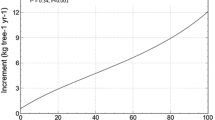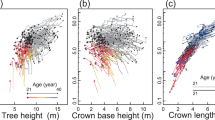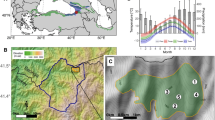Abstract
Large disturbances such as the 1988 Yellowstone fires produce considerable spatial heterogeneity in ecosystem processes across landscapes, in part by affecting vegetation structure. However, the persistence of this heterogeneity with time since disturbance, and thus the role of large disturbances in shaping the heterogeneity of ecosystem processes over large spatial and temporal scales, remains unclear. Such an inquiry requires that variability as well as mean conditions of forest structure and growth be examined if changes are to be projected for heterogeneous postdisturbance landscapes. We studied a chronosequence of unburned, mature lodgepole pine stands (stand ages ranging from 50 to 300 or more years) to examine the variability in stand density, leaf-area index (LAI), and stem growth [basal area increment (BAI), a surrogate for aboveground net primary productivity (ANPP)] with stand age, the relationships between these factors, and how these factors were related to stand and site characteristics. Variation in LAI and BAI was explained primarily by differences in stand density and age (r 2 = 0.51 for both LAI and BAI), and both LAI and BAI were most variable in the youngest age class [coefficient of variation (CV), 38% and 41% for LAI and BAI]. The relationship between LAI or BAI and stand density was significantly weaker (r 2 < 0.20) at stand ages characterized by canopy closure (50–175 years), suggesting that stand structure and production are closely linked. Thus, the spatial variability of stand production, which is initially very high following large fires in this landscape, is detectable for over a century before successional changes in forest structure greatly affect the initial postdisturbance landscape pattern of stand production. Given the recent focus on spatial heterogeneity of ecosystem processes across large landscapes, projecting changes in postdisturbance patterns of stand production has very strong significance for ecosystem science.






Similar content being viewed by others
References
SF Arno (1980) ArticleTitleForest fire history in the northern Rockies J For 78 460–5
E Assmann (1970) The principles of forest yield study Oxford Pergamon
WL Baker (1992) ArticleTitleThe landscape ecology of large disturbances in the design and management of nature reserves Landscape Ecol 7 181–94
D Binkley JL Stape MG Ryan HR Barnard J Fownes (2002) ArticleTitleAge-related decline in forest ecosystem growth: an individual-tree, stand-structure hypothesis Ecosystems 5 58–67
SL Brown PE Schroeder (1999) ArticleTitleSpatial patterns of aboveground productions and mortality of woody biomass for eastern U.S forests. Ecol Appl 9 968–80
IC Burke WK Laurenroth WJ Parton (1997) ArticleTitleRegional and temporal variation in net primary production and nitrogen mineralization in grasslands Ecology 78 1130–340
DA Clark S Brown DW Kicklighter JQ Chambers JE Thomlinson J Ni (2001) ArticleTitleMeasuring net primary production in forests: concepts and field methods Ecol Appl 11 356–70
WG Cochran (1977) Sampling Techniques EditionNumber3 John Wiley and Sons New York
PG Comeau JP Kimmins (1989) ArticleTitleAbove- and below-ground biomass and production of lodgepole pine on sites with differing soil moisture regimes Can J For Res 19 447–54
TJ Dean JN Long (1986) ArticleTitleVariation in sapwood area–leaf area relations within two stands of lodgepole pine For Sci 32 749–58
DG Despain (1990) Yellowstone vegetation Roberts Rinehart Boulder. (CO)
KS Fassnacht ST Gower (1997) ArticleTitleInterrelationships among the edaphic and stand characteristics, leaf area index, and aboveground net primary production of upland forest ecosystems in north central Wisconsin Can J For Res 27 1058–67
DR Foster DH Knight JF Franklin (1998) ArticleTitleLandscape patterns and legacies resulting from large, infrequent disturbances Ecosystems 1 497–510 Occurrence Handle10.1007/s100219900046
ST Gower JG Isebrands DW Sheriff (1995) Carbon allocation and accumulation in conifers WK Smith TM Hinckley (Eds) Resource physiology of conifers: acquisition, allocation, and utilization Academic New York 217–54
ST Gower RE McMurtrie D Murty (1996) ArticleTitleAboveground net primary production decline with stand age: potential causes Tree 11 378–82
ST Gower KA Vogt CC Grier (1992) ArticleTitleCarbon dynamics of Rocky Mountain Douglas-fir: influence of water and nutrient availability Ecol Monogr 62 43–65
JR Habeck RW Mutch (1973) ArticleTitleFire-dependent forests in the northern Rockies Quat Res 3 408–24
AJ Hansen JJ Rotella MPV Kraska D Brown (2000) ArticleTitleSpatial patterns of primary productivity in the Greater Yellowstone ecosystem Landscape Ecol 15 505–22 Occurrence Handle10.1023/A:1008127228878
DA Herbert JH Fownes (1995) ArticleTitlePhosphorous limitation of forest leaf area and net primary production on a highly weathered soil Biogeochemistry 29 223–35 Occurrence Handle1:CAS:528:DyaK2MXotFegsrw%3D
SB Jack JN Long (1991) ArticleTitleAnalysis of stand density effects on canopy structure: a conceptual approach Trees Struct Funct 5 44–9
JC Jenkins RA Birdsley Y Pan (2001) ArticleTitleBiomass and NPP estimation for the Mid-Atlantic region (USA) using plot-level forest inventory data Ecol Appl 11 1174–93
Kashian DM, Turner MG, Romme WH, Lorimer CG. 2005. Variability and convergence in conifereous stand structure with forest development on a fire-dominated subalpine landscape. Ecology. Forthcoming
MR Kaufmann MG Ryan (1992) ArticleTitlePhysiographic, stand, and environmental effects on individual tree growth and growth efficiency in subalpine forests Tree Physiol 2 47–59
RE Keane KC Ryan SW Running (1996) ArticleTitleSimulating effects of fire on northern Rocky Mountain landscapes with the ecological process model FIRE-BGC Tree Physiol 16 316–31
MG Keane GF Weetman (1987) ArticleTitleLeaf area-sapwood cross-sectional area relationship in repressed stands of lodgepole pine Can J For Res 17 205–9
AK Knapp JT Fahenstock SP Hamburg LB Statland TR Seastedt DS Schimel (1993) ArticleTitleLandscape patterns in soil–plant water relations and primary production in tallgrass prairie Ecology 74 549–60
DH Knight (1987) Parasites, lightning, and the vegetation mosaic in wilderness landscapes MG Turner (Eds) Landscape heterogeneity and disturbance Springer-Verlag New York 59–83
DH Knight TJ Fahey SW Running AT Harrison LL Wallace (1981) ArticleTitleTranspiration from 100-yr-old lodgepole pine forests estimated with whole-tree potometers Ecology 62 717–26
CL Kollenberg KL O’Hara (1999) ArticleTitleLeaf area and tree increment dynamics of even-aged and multiaged lodgepole pine stands in Montana Can J For Res 29 687–95
CM Litton MG Ryan DB Tinker DH Knight (2003) ArticleTitleBelow- and aboveground biomass in young postfire lodgepole pine forests of contrasting tree density Can J For Res 33 351–63
CM Litton MG Ryan DB Knight (2004) ArticleTitleEffects of tree density and stand age on carbon allocation patterns in postfire lodgepole pine Ecol Appl 14 460–475
JN Long TJ Dean (1986) ArticleTitleSapwood area of Pinus contorta stands as a function of mean size and density Oecologia (Berl) 68 410–2
JN Long FW Smith (1984) ArticleTitleRelation between size and density in developing stands: a description and possible mechanism For Ecol Manage 7 191–206
JN Long FW Smith (1988) ArticleTitleLeaf area–sapwood area relations of lodgepole pine as influenced by stand density and site index Can J For Res 18 247–50
JN Long FW Smith (1990) ArticleTitleDeterminants of stemwood production in Pinus contorta var. latifolia forests the influence of site quality and stand structure J Appl Ecol 27 847–56
JN Long FW Smith (1992) ArticleTitleVolume increment in Pinus contorta latifolia: the influence of stand development and crown dynamics For Ecol Manage 53 53–64
LL Loope GE Gruell (1973) ArticleTitleThe ecological role of fire in the Jackson Hole area, northwestern Wyoming Quat Res 3 425–43
BE Martner (1986) Wyoming climate atlas University of Nebraska Press Lincoln
MathSoft 1998. S-Plus 2000:rofessional release.
WH Moir R Francis (1972) ArticleTitleFoliage biomass and surface area in three Pinus contorta plots in Colorado For Sci 18 41–5
KJ Nadelhoffer JD Aber JM Melillo (1985) ArticleTitleFine roots, net primary production, and soil nitrogen availability: a new hypothesis Tree Physiol 16 187–200
U Olsson D Binkley FW Smith (1998) ArticleTitleNitrogen supply, nitrogen use, and production in an age sequence of lodgepole pine For Sci 44 454–7
JA Pearson TJ Fahey DH Knight (1984) ArticleTitleBiomass and leaf area in contrasting lodgepole pine forests Can J For Res 14 259–65
DA Perry (1994) Forest ecosystems Johns Hopkins University Press Baltimore
HR Pulliam (1988) ArticleTitleSources, sinks, and population regulation Am Nat 132 652–61 Occurrence Handle10.1086/284880
HR Pulliam BJ Danielson (1991) ArticleTitleSources, sinks, and habitat selection: a landscape perspective on population dynamics Am Nat 137 S50–S66 Occurrence Handle10.1086/285139
RA Reed ME Finley WH Romme MG Turner (1998) ArticleTitleAboveground net primary production and leaf-area index in early postfire vegetation in Yellowstone National Park Ecosystems 2 88–94 Occurrence Handle10.1007/s100219900061
InstitutionalAuthorNameRegent Instruments. (2001) WinDendro 2001a Regent Instruments Quebec
WH Romme (1982) ArticleTitleFire and landscape diversity in subalpine forests of Yellowstone National Park Ecol Monogr 52 199–221
WH Romme DG Despain (1989) ArticleTitleHistorical perspective on the Yellowstone fires of 1988 BioScience 39 695–9
WH Romme DH Knight (1981) ArticleTitleFire frequency and subalpine forest succession along a topographic gradient in Wyoming Ecology 62 319–26
WH Romme DH Knight (1982) ArticleTitleLandscape diversity: the concept applied to Yellowstone Park Bioscience 32 664–70
MG Ryan D Binkley JH Fownes (1997) ArticleTitleAge-related decline in forest productivity: pattern and process Adv Ecol Res 27 213–62 Occurrence Handle10.1016/S0065-2504(08)60009-4
MG Ryan RH Waring (1992) ArticleTitleMaintenance respiration and stand development in a subalpine lodgepole pine forest Ecology 73 2100–8
OE Sala WJ Parton LA Joyce WK Lauenroth (1988) ArticleTitlePrimary production of the central grassland region of the United States Ecology 69 40–5
DS Schimel VEMAP participants BH Braswell (1997) ArticleTitleContinental scale variability in ecosystem processes: models, data, and the role of disturbance Ecol Monogr 67 251–71
FW Smith JN Long (2001) ArticleTitleAge-related decline in forest growth: an emergent property For Ecol Manage 144 175–81
FW Smith SC Resh (1999) ArticleTitleAge-related changes in production and below-ground carbon allocation in Pinus contorta forests For Sci 45 333–41
P Snowdon ML Benson (1992) ArticleTitleEffects of combinations of irrigation and fertilization on the growth of aboveground biomass production of Pinus radiata For Ecol Manage 52 87–116
InstitutionalAuthorNameSPSS. (1996) SYSTAT 6.0 for Windows SPSS Richmond (CA)
DB Tinker WH Romme DG Despain (2003) ArticleTitleHistoric range of variability in landscape structure in subalpine forests of the Greater Yellowstone Area Land Ecol 18 427–439
J Turner JN Long (1975) ArticleTitleAccumulation of organic matter in a series of Douglas-fir stands Can J For Res 5 681–90
MG Turner WH Hargrove RH Gardner WH Romme (1994) ArticleTitleEffects of fire on landscape heterogeneity in Yellowstone National Park, Wyoming J Vegetat Sci 5 731–42
MG Turner WH Romme (1994) ArticleTitleLandscape dynamics in crown fire ecosystems Landscape Ecol 9 59–77
MG Turner DB Tinker WH Romme DM Kashian CM Litton (2004) ArticleTitleLandscape patterns of sapling density, leaf area, and aboveground net primary production in postfire lodgepole pine forests, Yellowstone National Park (USA) Ecosystems 7 751–775
RH Waring (1983) ArticleTitleEstimating forest growth and efficiency in relation to canopy leaf area Adv Ecol Res 13 327–54
RH Whittaker WA Nehring (1975) ArticleTitleVegetation of the Santa Catalina Mountains, Arizona V. Biomass, production, and diversity along the elevation gradient. Ecology 56 771–90
C Wirth E-D Schulze V Kusznetova I Milyukoa G Hardes M Siry B Schulze NN Vygodskaya (2002) ArticleTitleComparing the influence of site quality, stand age, fire and climate on aboveground tree production in Siberian Scots pine forests Tree Physiol 22 537–52 Occurrence Handle1:STN:280:DC%2BD38zgsVehsw%3D%3D Occurrence Handle12045026
HE Wright SuffixJr ML Heinselman (1973) ArticleTitleIntroduction to symposium on the ecological role of fire in natural coniferous forests of western and northern America Quat Res 3 319–28
JH Zar (1999) Biostatistical analyses EditionNumber4 Prentice-Hall Upper Saddle River (NJ)
Acknowledgments
For their fearless and enthusiastic assistance in the field, braving boat, bear, and bison, we thank Teresa Cohn, Sarah Cross, Katherine Findley, Heather Lyons, Brian Schwingle, Crystal Van Cutsem, and Steve Wangen. Creighton Litton was extremely helpful in conceptual discussions, and Dennis Knight provided ideas, direction, and encouragement in the early stages of this study. Jun Zhu provided statistical advice and support, and the University of Wyoming–National Park Service Research Station provided logistical support throughout the study. Tom Gower, Dennis Knight, and Mike Ryan made helpful comments on earlier versions of this article. This research was funded by the National Science Foundation Ecology and Ecosystem Studies Program (grant DEB-9806440), the Andrew Mellon Foundation, the UW-NPS Research Station, and the University of Wisconsin Department of Zoology.
Author information
Authors and Affiliations
Corresponding author
Rights and permissions
About this article
Cite this article
Kashian, D.M., Turner, M.G. & Romme, W.H. Variability in Leaf Area and Stemwood Increment Along a 300-year Lodgepole Pine Chronosequence. Ecosystems 8, 48–61 (2005). https://doi.org/10.1007/s10021-004-0067-1
Received:
Accepted:
Published:
Issue Date:
DOI: https://doi.org/10.1007/s10021-004-0067-1




